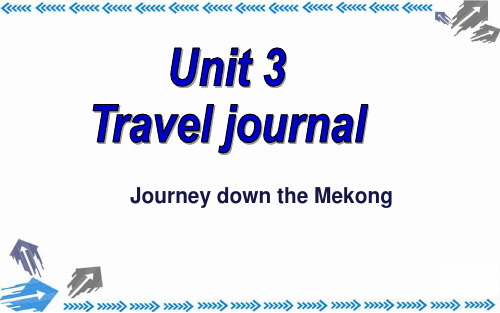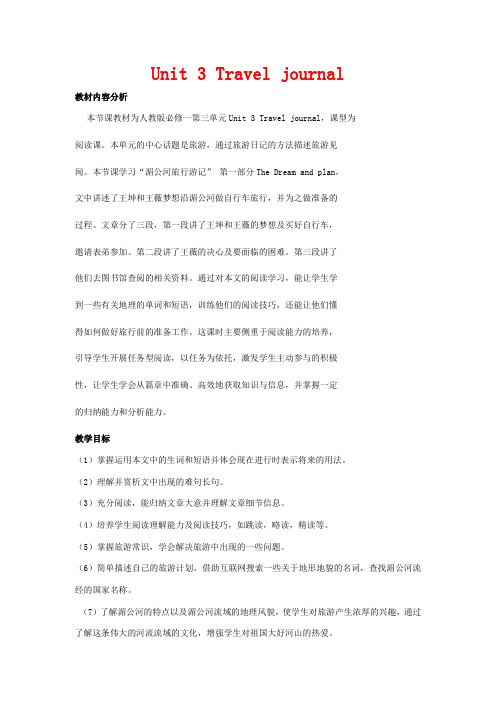高中英语 Unit 3 Travel journal Reading Journey down the Mekong课件 新人教版必修1
- 格式:ppt
- 大小:6.94 MB
- 文档页数:61





英语教学设计教学课题:人教版高中英语必修一Unit 3 Travel journal Reading: Journey down the Mekong一、设计思路高中英语课程的总目标是使学生在义务教育阶段英语学习基础上,进一步明确英语学习目的,发展自主学习和合作学习的能力;形成有效的英语学习策略,培养学生的综合语言运用能力,使他们在学习过程中,促进心智、情感态度,学习策略,文化意识的发展,形成正确的人生观和价值观,提高人文素养。
该课程标准强调“使语言学习的过程成为学生形成积极地情感态度、主动思维和大胆实践的过程。
”英语教学是一种教与学的双边活动,教学的实质是交际。
从这个意义出发,阅读不应是传统意义上的接受性技能(receptive skill ), 而是一个积极主动的思考理解及获取信息的过程,同时也是作者与阅读者双方参与的言语交际、思想交流的过程。
信息时代的到来需要人们进行广泛而有效的阅读,因而对阅读技巧的培养也提出了更高的要求。
因此,我结合新课标和学生的实际,以任务型教学模式贯穿始终,引导学生自主或者合作完成。
阅读活动由整体入手,由易到难,层层深入。
教学过程中,发挥网络在教学中的优势,图文并茂让学生对主题信息有一个直观的了解。
整个教学活动以教材为载体,以学生为中心,学生参与活动。
二、教学内容分析(一)教材分析1、这节课使用的教材是人教版高中英语必修1,这套教材是在任务型语言教学理念的基础上编写的,它以话题为主线,贴近学生生活,贴近真实的教学行为,它的语言教学理念是强调语言的运用,促进学生自主学习,发展学习的策略,培养创新精神突出实践能力。
2. 第3单元的中心话题是“旅游” ,是一个时尚和热门的话题,不同地区的文化氛围、风土人情和地理特征都能引起学生浓厚的兴趣,激发他们的求知欲。
本节课是这个单元的阅读部分,是王坤写的一篇日记,讲述了她和姐姐想骑山地车旅行,选定了湄公河作为旅游路线,文章具体谈到了他们为这次旅游做的各项准备工作。

Unit 3 Travel journal教材内容分析本节课教材为人教版必修一第三单元Unit 3 Travel journal,课型为阅读课。
本单元的中心话题是旅游,通过旅游日记的方法描述旅游见闻。
本节课学习“湄公河旅行游记”第一部分The Dream and plan,文中讲述了王坤和王薇梦想沿湄公河做自行车旅行,并为之做准备的过程。
文章分了三段,第一段讲了王坤和王薇的梦想及买好自行车,邀请表弟参加。
第二段讲了王薇的决心及要面临的困难。
第三段讲了他们去图书馆查阅的相关资料。
通过对本文的阅读学习,能让学生学到一些有关地理的单词和短语,训练他们的阅读技巧,还能让他们懂得如何做好旅行前的准备工作。
这课时主要侧重于阅读能力的培养,引导学生开展任务型阅读,以任务为依托,激发学生主动参与的积极性,让学生学会从篇章中准确、高效地获取知识与信息,并掌握一定的归纳能力和分析能力。
教学目标(1)掌握运用本文中的生词和短语并体会现在进行时表示将来的用法。
(2)理解并赏析文中出现的难句长句。
(3)充分阅读,能归纳文章大意并理解文章细节信息。
(4)培养学生阅读理解能力及阅读技巧,如跳读,略读,精读等。
(5)掌握旅游常识,学会解决旅游中出现的一些问题。
(6)简单描述自己的旅游计划,借助互联网搜索一些关于地形地貌的名词,查找湄公河流经的国家名称。
(7)了解湄公河的特点以及湄公河流域的地理风貌,使学生对旅游产生浓厚的兴趣,通过了解这条伟大的河流流域的文化,增强学生对祖国大好河山的热爱。
教学过程Step 1 Greetings and leading inShow some pictures of some world-famous places of interest to arouse their interest in the topic related to this unit.Aims: to arouse interest and lead in reading.Step 2 Warming upGuessing game — Divide the whole class into 2 groups. Let the students have a competition. Show the following on the screen.Task 1. Match the famous rivers and the countries where they are located.The great rivers in the worldTask 3. In China, the Mekong River is called the Lancang River, and out of China, it is called the Mekong River. Can you list the countries that the Mekong River flows through?(Keys: China→Myanmar→Laos→Thailand→Cambodia→Vietnam→South China Sea) Aims: to introduce the unit topic and arouse students’ interests in class activities.Step 3. ReadingI. Fast reading(Reading tips: Skim the whole passage quickly and silently and pay attention to the passage structure. Don’t worry about the details or new words.)Task 1. Get the students to read the passage quickly and then match the main idea of each part.Part 1 para 1 A. PreparationPart 2 para 2 B. A stubborn sisterPart 3 para 3 C. DreamTask 2. Get the students to fill in the blanks.Main idea: The text mainly tells us about _________and___________of Wang Kun and Wang Wei and how they will cycle along the _________.(Key: the dream, the plan, Mekong River )Aims: to develop students’ reading ability to get the main idea and certain information.II. Careful reading(Reading tips: Read the passage more carefully and find more detailed information.) Get the students to read the passage more carefully and find more information about their journey and then finish the following tasks .Task1. Read Para1 and find more information about their dream.1. Match the time with the things that happen.2. Find more details about their dream(1). Who and what: Wang Kun and _____ ______ are dreaming about _____________. (Key: Wang Wei, taking a great bike trip )(2). Where and how: They have the idea to ____ _____ the Mekong River from where it ______ to where it ____. (Key: cycle along, begins, ends)Task2. Read Para2 and Answer the questions below.1. Where is the source of the Mekong River?(Key: The source of the river is in Qinghai Province.)2. Is it a difficult journey along the Mekong River? Why?(Key: Yes. The journey begins at an altitude of more than 5,000 meters, where it is hard to breathe and very cold. (line22))3. What kind of person is Wangwei?(Key: She is very stubborn. Once she has made up her mind, nothing can change it. (line25))Task3. Read Para3 and fill in the blanks.The Mekong RiverIt begins at ___________________________, moves ______ and passes through __________. Half of it is in ______.It enters _________________.Then it travels slowly through _____________where rice grows.At last it enters ___________________ .(Key: a glacier on a Tibetan mountain, quickly, deep valleys, China,the Southeast Asia, low valleys to plains, the South China Sea.)Task4. Let’s enjoy the beautiful scenery along the Mekong River.III. Sentence appreciation:Translate some difficult sentences and read them aloud.1. It was my sister who first had the idea to cycle along the entire Mekong River from where it begins to where it ends.(Key: 首先想到沿湄公河从源头到终点骑车旅游的是我的姐姐。
Unit 3 Travel journalReading: Journey down the MekongTeaching goals1.Learn something about the Mekong River through reading.2.Students can use what they have learned to introduce the Mekong River.3.Students should get some new words and expressions.Teaching important and difficult points:1.Understand the text well.2.Try to master the useful new words & expressions in this period.Teaching aids: a computer & a projectorTeaching proceduresStep ⅠWarming UpT: Do you like travelling?Present some pictures of beautiful places to arouse their interest of travelling. Meanwhile, the teacher can also ask some more questions to make the students say something about their journey, such as their plans of trips, the difficulties they met in their journey and so on.Step ⅡLead InT: Q1:Have you visited any river?Q2: How many great rivers do you know?Q3: If you could travel down only one of them, which one would you choose? Why?Ask the students the locations of some famous rivers in the world. (Mekong, Rhein, Seine, Nile, Thames, Congo, Amazon, Mississippi, Volg)Step ⅢPre-readingT: Have you visited the Mekong River? If no, let’s learn something about it.1. Show a picture of the Mekong River and the brief introduction of it. Ask them:Can you list the countries that the Mekong River flows through?3.Enjoy the beautiful sights along the Mekong River to arouse their interest of it.Step IV ReadingIn this step, get the students to read the text and finish some tasks.Task1: Listen to the tape, then match the main idea of each para.Para.1 preparation for their tripPara.2 their dreamPara.3 a stubborn sisterTask2: Read para.1 and para.2 carefully, then answer some questionsQ1. Who are Wang kun and Wang Wei?Q2.What are their dreams?Q3.Who are Dao Wei and Y u Hang?Q4. Is it a difficult journey to cycle along the Mekong? Why?Q5.What can you see when you travel along the Mekong River?Task3: Careful reading for para.3 and find out the information of the Mekong.Task4: Group workWork in groups of 4 and try to be a tour guide and introduce the Mekong.Fill in the blanks•①The Mekong River which is called the Lancang River in China begins in a ______ ona Tibetan mountain and enters the ________________ at last.•②At first the river is small and the water is ______ and _____. Then it begins to move ______. Sometimes it becomes ______, sometimes it becomes a __________.After it leaves China and high altitude, it becomes ____, _____ and _____. As it enters Southeast Asia, its ____ slows.Step V Post-readingTask 1:Make comparisonAn attitude is what a person thinks about something. Make lists of Wang Wei’s and Wang Kun’s similar and different attitudes about the trip.Task 2: DebateWhich character do you like, Wang Kun or Wang wei? Why?Task 3: Understand two mottosKeep everything before a rainy day.未雨绸缪,有备无患。